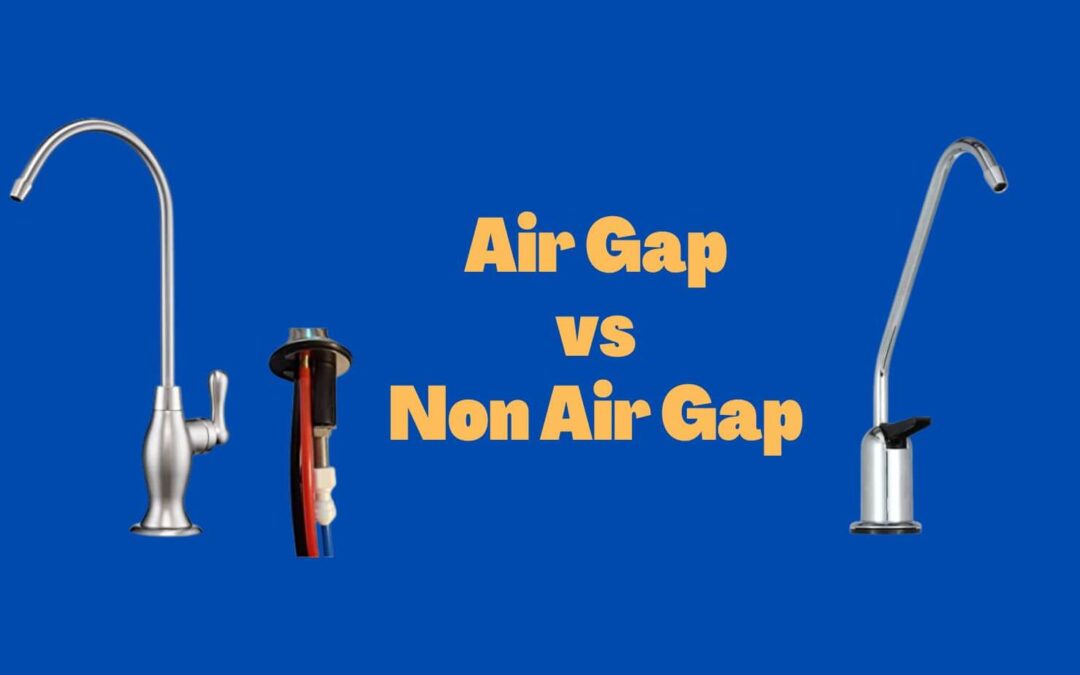Reverse Osmosis systems are made standard accompanied by an air gap faucet. However, most of the RO system vendors also provide a non-gap choice. In addition, most Reverse Osmosis drinking water systems ensure water flows to the drain. This is a result of the good performing nature of Reverse Osmosis filtration.
The RO membrane continuously cleans itself for your system always to release clean water. This allows the impurities to flow to the drain. The main difference between the two Reverse Osmosis is that the Air Gap Faucet is made to create a physical siphon break from the Reverse Osmosis system.
It works by hand with the sink drain by releasing water from different tubes via air. Both types of faucets have their pros and cons. Their diverse functions and models are what we will discuss in the article below. I have further tackled the frequently asked questions and finally given a grasp of the content in conclusion.
Purpose Of An Air Gap Faucet
The air gap system connects the units and drains water going the upper direction via a flexible tube, usually 1/4 to a tiny basin made at the bottom of the faucet. The action allows water to flow through the non-pressured basin to one of the sides of the faucet stem.
The water further gets into a hole and forcefully hits a flexible tube made 3/8″ that gets into the under-sink drain pipe. The whole procedure needs the air gap faucet to have at least three tubes (Upward drain water, downward drain water, units product water, and the clean water you take). In addition, the air gap faucet must have a larger baseline that needs a bigger hole in the sink. When using an air gap faucet, the drain line water from the Reverse Osmosis membrane is connected with a baseline of the faucet. The connection leads it to fall into the non-pressured basin and move by force to the drain sink.
However, Reverse Osmosis allows the non-air gap faucet to send the drain line water to the drain sink. A non-air faucet further has the drinking water line attached to it.
The air-gap faucet is made, so the drain sink is backed up and clogged. The air gap in the Reverse Osmosis discharge line will prefer pulling a tiny air ratio to dirty water to its RO unit.
Features of Air Gap Faucet
1. Three tubes as compared to one
The air gap having three tubes compared to one is one feature that greatly helps the system. The first one helps for the upward drain water, the second one covers the downward drain water, and the third one represents the unit products water, the clean water you take.
2. Small hole
The tiny hole in its body allows water to get out to the countertop, or the sink drain tube can be clogged. This action is mainly seen because drain water is running under low pressure. Pieces of food remaining and debris can block the inlet of the drain line, causing the water to pull into the countertop.
3. Wider base
The large-sized base needs a bigger hole in the sink during installation. However, this brings a cumbersome installation process.
|
Feature |
Air gap faucet | Non-air gap faucet |
| Installation | Difficult to install | Easy to install |
| Cost | Relatively expensive | Cheap |
| Noise | Produces gurgling sound | No gurgling sound |
| Plumbing code | Reverse system | Non-compliant |
| System protection | Destroyed easily | Not destroyed easily |
1. Installation
Air Gap reverse osmosis faucet is challenging to install due to many tubes and connections, which confuse the installation activity. At the same time, non-gap faucets are easy to install due to the minimum tubes and connections available.
2. Cost
The air gap faucet is relatively expensive due to the many tubes needed to complete the system. But for the non-air gap faucet, the cost is cheap due to the fewer tubes and connections required.
3. Noise
During the system’s operation, air gap faucets produce a gargling sound. The sound is a result of the natural air barrier of water hitting the trough or when the storage tank is being filled with water. For the non-gap faucets, no gurgling sound is hard because the drain line originating from the reverse membrane moves to the sink drain line.
4. Plumbing codes
In the Air gap faucet, most places need utilization of the Air Gap faucet together with the reverse system. But in non-air gap faucets, the plumbing codes are considered non-compliant in a few cities/counties.
5. System protection
The air gap faucet works in the scenario where a blocked drain sink. This is because the physical line break in the air gap system ensures water is not pulled back to the reverse system. But for the non-gap faucets, there are high chances if the drain backs up, the reverse osmosis system can be tampered with and destroyed, or even the membrane spoilt.
Use of air gap faucet
The air gap faucet dispenses water similar to standard non-air gap faucets. However, they have a sir gap attached to the bottom of the faucet. Air gap faucets are built to withstand backflow into the Reverse Osmosis unit. This is done by paying keen attention to preventing backflow through an air gap method.
In case of clogging, using the minimum amount of air to that of contaminated water flows back to the RO system hence system protection. This goes hand in hand with the dishwasher air gap that ensures dirty water does not flow into the clean water of the dishwasher.
A reverse osmosis air gap faucet prevents dirty water from pulling back into the reverse osmosis filtration system. Always ensure you provide high maintenance to enable your system to work for a long time smoothly.
Air-Gap Faucet Installation Ideas
Installing an air gap faucet needs some important aspects. First, the faucet you are using has a tiny hole in its system. The hole allows water to move out of the countertop or sink if the drain tube is clogged. Remember that the hole is one of the features of an air gap device.
It is advisable to keep the hole open to allow free debris. For example, a faucet lacks a hole that is not called an air gap faucet. In the hole, contaminated water flows to the top and out via the base.
Several local plumbing codes enable you to install a line check valve to prevent the backflow of water. This allows the utilization of the non-air gap faucet, disregarding the noise that comes with air gap faucets. Kindly follow the manufacturer’s manual and understand every specification needed to ensure the smooth running of the system.
Frequently asked questions
Why are Air Gap Faucets Noisy?
Mostly, Reverse Osmosis systems produce no noise. However, you can hear some sounds when contaminated water moves from the membrane to the drain. Reverse Osmosis is unique so that cross-flow water causes the dirty concentrated water to flush away from the system.
Hence, the flushing maintains the unit from fouling. When the storage tank is full and you have an air gap system, there are high chances you will hear some sounds. When the tank is filled with water, the water pressure that hits the drain line under the faucet causes the noise. The moving water flows to the air gap basin and moves down to the drain sink.
Note that the slow movement of water results in a gurgling sound.
In case you hear a hissing sound, it is advisable to contact help from an expert on water treatment, as the issue might be leaks, air gaps, or water pressure.
How Does An Air Gap Work?
If you experience an issue such as clogging and the water pulls into the sink, be sure the water cannot flow to the faucet outlet due to the air gap in between.
Is Air Gap Necessary For Reverse Osmosis?
Reverse osmosis systems come with an in-built air gap faucet. However, most reverse osmosis system vendors offer non-air gap choices.
How Do You Clean An Air Gap Faucet?
With the help of a bottle brush, you can do further extensions to the bottom of the air gap and twist until all the debris is loose.
How Do You Fix A Clogged Air Gap?
For soft clogging, remove the cap from the air gap, and put tube cardboard originating in the roll of towels above the hole. In case of failure, use a long bottle brush or vacuum.
When NOT to use an Air Gap Faucet?
An air gap faucet is not needed in Samsung dishwashing because the absence or presence of the air gap has no direct issues with the regular operation of the system.
Final Words
You can install a small reverse osmosis filtration system in your kitchen house to provide high-quality drinking water. Some people refer to it as a ‘point of use” water filtration system, and you can further attach it to the ice machine and your fridge.
Remember, water pressure is a key value in most refrigerators. It is advisable to read the reverse osmosis manual to understand how you can go about it. If you experience difficulties handling the system, contact help from a certified professional.

As the chief content writer, Hassan Al Sarker works as a professional kitchen-based content creator at Kitchen Liker.
In addition to reviewing the content published on Kitchen Liker, he ensures that it is accurate, relevant, and helpful. As a result, all the reviews and information published at Kitchen Liker are neutral and userfriendly.
Hassan Al Sarker has a bachelor’s degree in Hotel and Tourism Management From the Newyork University. Before joining Kitchen Liker, he was a contributor at Kitchen Club, United States.

